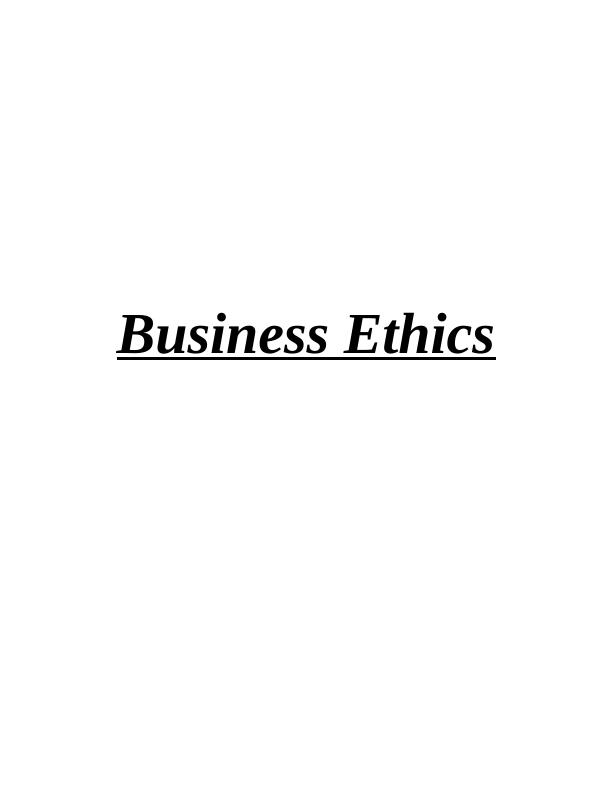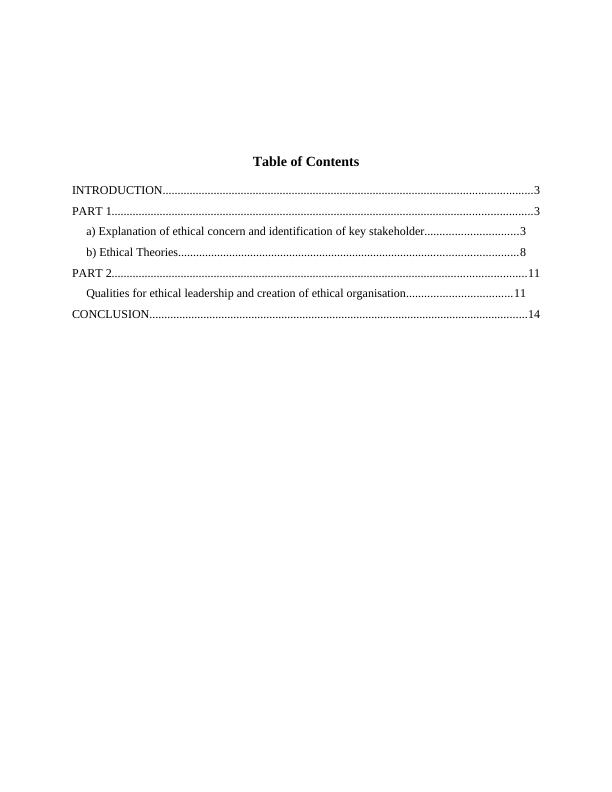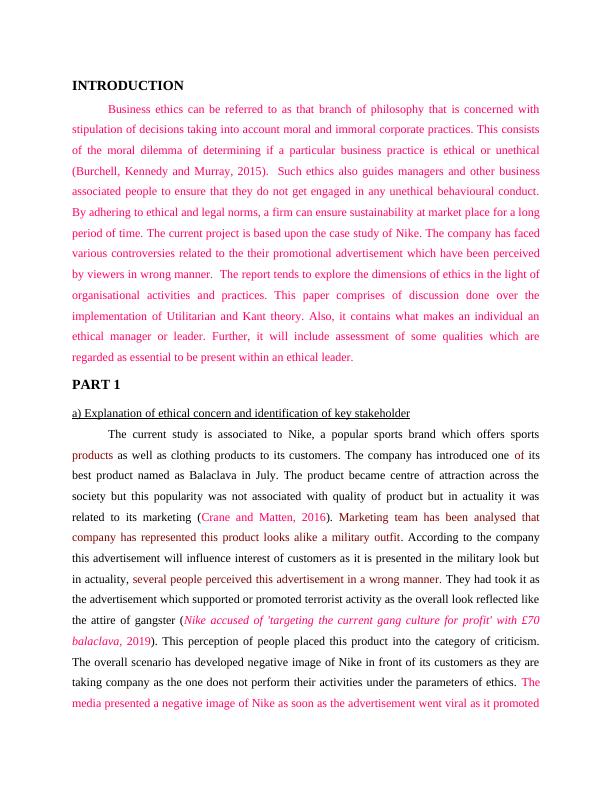Business Ethics: Ethical Concerns and Stakeholder Identification
Added on 2023-01-19
14 Pages4327 Words36 Views
Business Ethics

Table of Contents
INTRODUCTION...........................................................................................................................3
PART 1............................................................................................................................................3
a) Explanation of ethical concern and identification of key stakeholder...............................3
b) Ethical Theories.................................................................................................................8
PART 2..........................................................................................................................................11
Qualities for ethical leadership and creation of ethical organisation...................................11
CONCLUSION..............................................................................................................................14
INTRODUCTION...........................................................................................................................3
PART 1............................................................................................................................................3
a) Explanation of ethical concern and identification of key stakeholder...............................3
b) Ethical Theories.................................................................................................................8
PART 2..........................................................................................................................................11
Qualities for ethical leadership and creation of ethical organisation...................................11
CONCLUSION..............................................................................................................................14

INTRODUCTION
Business ethics can be referred to as that branch of philosophy that is concerned with
stipulation of decisions taking into account moral and immoral corporate practices. This consists
of the moral dilemma of determining if a particular business practice is ethical or unethical
(Burchell, Kennedy and Murray, 2015). Such ethics also guides managers and other business
associated people to ensure that they do not get engaged in any unethical behavioural conduct.
By adhering to ethical and legal norms, a firm can ensure sustainability at market place for a long
period of time. The current project is based upon the case study of Nike. The company has faced
various controversies related to the their promotional advertisement which have been perceived
by viewers in wrong manner. The report tends to explore the dimensions of ethics in the light of
organisational activities and practices. This paper comprises of discussion done over the
implementation of Utilitarian and Kant theory. Also, it contains what makes an individual an
ethical manager or leader. Further, it will include assessment of some qualities which are
regarded as essential to be present within an ethical leader.
PART 1
a) Explanation of ethical concern and identification of key stakeholder
The current study is associated to Nike, a popular sports brand which offers sports
products as well as clothing products to its customers. The company has introduced one of its
best product named as Balaclava in July. The product became centre of attraction across the
society but this popularity was not associated with quality of product but in actuality it was
related to its marketing (Crane and Matten, 2016). Marketing team has been analysed that
company has represented this product looks alike a military outfit. According to the company
this advertisement will influence interest of customers as it is presented in the military look but
in actuality, several people perceived this advertisement in a wrong manner. They had took it as
the advertisement which supported or promoted terrorist activity as the overall look reflected like
the attire of gangster (Nike accused of 'targeting the current gang culture for profit' with £70
balaclava, 2019). This perception of people placed this product into the category of criticism.
The overall scenario has developed negative image of Nike in front of its customers as they are
taking company as the one does not perform their activities under the parameters of ethics. The
media presented a negative image of Nike as soon as the advertisement went viral as it promoted
Business ethics can be referred to as that branch of philosophy that is concerned with
stipulation of decisions taking into account moral and immoral corporate practices. This consists
of the moral dilemma of determining if a particular business practice is ethical or unethical
(Burchell, Kennedy and Murray, 2015). Such ethics also guides managers and other business
associated people to ensure that they do not get engaged in any unethical behavioural conduct.
By adhering to ethical and legal norms, a firm can ensure sustainability at market place for a long
period of time. The current project is based upon the case study of Nike. The company has faced
various controversies related to the their promotional advertisement which have been perceived
by viewers in wrong manner. The report tends to explore the dimensions of ethics in the light of
organisational activities and practices. This paper comprises of discussion done over the
implementation of Utilitarian and Kant theory. Also, it contains what makes an individual an
ethical manager or leader. Further, it will include assessment of some qualities which are
regarded as essential to be present within an ethical leader.
PART 1
a) Explanation of ethical concern and identification of key stakeholder
The current study is associated to Nike, a popular sports brand which offers sports
products as well as clothing products to its customers. The company has introduced one of its
best product named as Balaclava in July. The product became centre of attraction across the
society but this popularity was not associated with quality of product but in actuality it was
related to its marketing (Crane and Matten, 2016). Marketing team has been analysed that
company has represented this product looks alike a military outfit. According to the company
this advertisement will influence interest of customers as it is presented in the military look but
in actuality, several people perceived this advertisement in a wrong manner. They had took it as
the advertisement which supported or promoted terrorist activity as the overall look reflected like
the attire of gangster (Nike accused of 'targeting the current gang culture for profit' with £70
balaclava, 2019). This perception of people placed this product into the category of criticism.
The overall scenario has developed negative image of Nike in front of its customers as they are
taking company as the one does not perform their activities under the parameters of ethics. The
media presented a negative image of Nike as soon as the advertisement went viral as it promoted

an unethical illustration of an individual in gangster look. The press stressed upon the fact that
even if the intention of company was not to influence the young generation in a negative manner,
it somehow affected the youngsters adversely. As Nike ignored or neglected the negative
publicity that was done of the company, effects were seen on its sales performance. In order to
protect themselves the company has also placed many claims such as they developed this product
for protecting individuals from the cold in winter season. But, for gaining customers positive
influence, the company has said that they will ensure that marketing team will further emphasize
on pursuing ethical norms and also consider society at the time of promoting product among
customer. Here, it is essential for marketing department to focus on choosing right intention
about the product so that they present same intention and values of product in front of customers
at the time of presenting it to them in advertisements. As the company was accused by the press
of promoting gang culture, it is of key importance for Nike to concentrate on using ethical and
societal aspect at the finalising any advertisement for the company. This will help them in
developing positive image of the company in front of customers as slowly slowly they will
accept Nike again. As a result, it will contribute in the enhancement of organisations sales
performance effectively.
Stakeholders concepts
With reference to the Nike, Key stakeholder for this company are investors, employees,
suppliers and customers who placed influence over the power utilisation as well as decision
making of the Nike at extent level. As per current situation, it has been analysed that Nike
requires support of its stakeholder in overcoming criticism faced for the Balaclava. It can be said
that support of stakeholders will help company in gaining its positive image back among society.
In this regard, for enhancing relationship of stakeholders with Nike, top management of the
company is required to follow stakeholder theory as it will guide them in taking effective
decisions which will ensure welfare of stakeholders (Dierksmeier, 2011). This theory can be well
understood by deeply analysing influence/ interest matrix which states actual status that is
influence or interest of its stakeholders within the company.
even if the intention of company was not to influence the young generation in a negative manner,
it somehow affected the youngsters adversely. As Nike ignored or neglected the negative
publicity that was done of the company, effects were seen on its sales performance. In order to
protect themselves the company has also placed many claims such as they developed this product
for protecting individuals from the cold in winter season. But, for gaining customers positive
influence, the company has said that they will ensure that marketing team will further emphasize
on pursuing ethical norms and also consider society at the time of promoting product among
customer. Here, it is essential for marketing department to focus on choosing right intention
about the product so that they present same intention and values of product in front of customers
at the time of presenting it to them in advertisements. As the company was accused by the press
of promoting gang culture, it is of key importance for Nike to concentrate on using ethical and
societal aspect at the finalising any advertisement for the company. This will help them in
developing positive image of the company in front of customers as slowly slowly they will
accept Nike again. As a result, it will contribute in the enhancement of organisations sales
performance effectively.
Stakeholders concepts
With reference to the Nike, Key stakeholder for this company are investors, employees,
suppliers and customers who placed influence over the power utilisation as well as decision
making of the Nike at extent level. As per current situation, it has been analysed that Nike
requires support of its stakeholder in overcoming criticism faced for the Balaclava. It can be said
that support of stakeholders will help company in gaining its positive image back among society.
In this regard, for enhancing relationship of stakeholders with Nike, top management of the
company is required to follow stakeholder theory as it will guide them in taking effective
decisions which will ensure welfare of stakeholders (Dierksmeier, 2011). This theory can be well
understood by deeply analysing influence/ interest matrix which states actual status that is
influence or interest of its stakeholders within the company.

End of preview
Want to access all the pages? Upload your documents or become a member.
Related Documents
Ethical Business Practices and Policies in the Context of Ethicslg...
|14
|4232
|311
Business Ethics & Responsible Managementlg...
|12
|3846
|192
Ethical Thinking and Practice : Case Studylg...
|13
|4287
|347
Business Ethics Of Nike : Case Studylg...
|12
|3674
|231
Business Ethics of NIKE : Reportlg...
|12
|3464
|220
Business Ethics: Unethical Practices and Stakeholder Impactlg...
|9
|2511
|23
